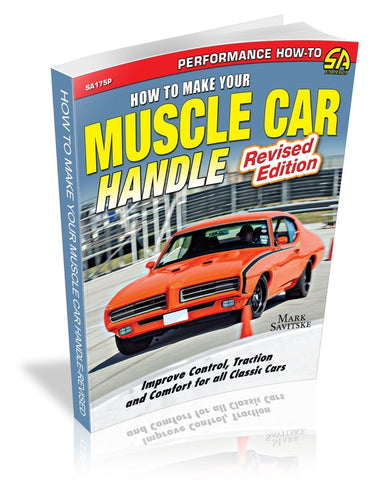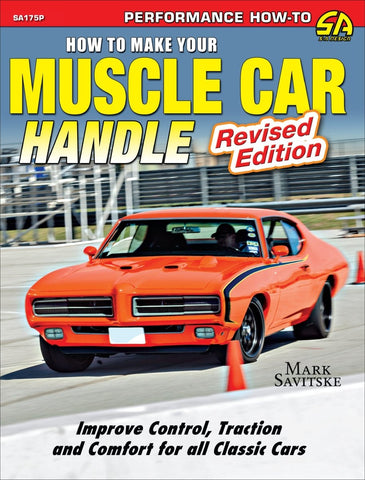When automotive manufacturers stuffed large V-8 engines into intermediate-size cars, the American muscle car was born. Built from 1964 on, the vast majority of these amazingly fast machines did not carry cutting-edge chassis and suspension systems, and now these cars are up to 50 years old. Today, owners do not have to settle for poor handling and ride quality.
Muscle car and suspension expert Mark Savitske has built his business, Savitske Classic and Custom, on making muscle cars handle and ride at their best. With this updated edition, Savitske shows you what it takes to transform the handling of these high-horsepower machines. He explains the front and rear suspension geometry so you understand how it functions, and in turn, you realize how to get the most from a particular system. He also reveals the important aspects of spring rates, shock dampening, and ride height so you select the best spring and shock package for your car and application. He discusses popular high-performance tubular suspension arms and sway bars, so you can find the right combination of performance and adjustability. The suspension system has to operate as an integrated part of the car, so you're shown how to select best suspension package for a well-balanced and responsive car. He also discusses how to extract maximum performance from popular GM, Ford, and Mopar muscle cars.
You can harness the performance potential of your muscle car and put much more power to the ground with critical chassis and suspension updates and products. A muscle car that carries modern suspension technology not only provides far better handling and ride comfort, but it is also much safer. How to Make Your Muscle Car Handle is the essential guide to unlocking the handling and performance potential of your muscle car. If you yearn for better handling, comfort, and performance for your muscle car, this is the book for you.
Acknowledgments
Introduction
Chapter 1:
General Front End Geometry
Standard Definitions
Front Suspension Relationships
Bump Steer
SLA vs. Strut
SLA Suspension Fixes
Chapter 2:
General Rear Suspension Geometry
Rear Suspension
Relationships
Leaf-Spring/Hotchkiss Suspensions
Four-Link Suspensions
Torque Arm Suspensions
Three-Link Suspensions
Ladder-Bar Suspensions
Truck-Arm Suspensions
Lateral Axle Locators
Solid Axle vs. IRS Suspensions
Chapter 3:
Springs, Rates and Shocks
Springs
Ride Height
Spring Rate
Air Springs
Shock Absorber Technology
Coil-Over vs. Coil Spring
Chapter 4:
Aftermarket Arms
Metal Matters
Design Development
Tubular Lower A-Arms
Bushings
Chapter 5:
Sway Bars
Basics of Function
Learn What You Need
Selection Tips
Adaptation Options
Rear Bars
End Links
Heimu2008Joints
Splined Bars
Quality Matters
Chapter 6:
Wheels and Tires
General Tire Behavior
Wheel Diameter
Tire Selection
Chapter 7:
Total Package
Chassis Stiffness
Chapter 8:
GM Muscle Cars
GM A-Body
GM G-Body 1981 to 1988
GM First-Generation F-Body
GM Second-Generation F-Body
GM Third-Generation F-Body
Chapter 9:
Ford Muscle Cars 123
Front Suspension Options 123
Rear Suspension Options 128
Ford Fox Body 1974 to 1978 131
Ford Fox Body 1979 to 1993 132
Chapter 10:
Mopar Muscle Cars
Front Suspension
Rear Suspension
Afterword
Source Guide
When automotive manufacturers stuffed large V-8 engines into intermediate-size cars, the American muscle car was born. Built from 1964 on, the vast majority of these amazingly fast machines did not carry cutting-edge chassis and suspension systems, and now these cars are up to 50 years old. Today, owners do not have to settle for poor handling and ride quality.
Muscle car and suspension expert Mark Savitske has built his business, Savitske Classic and Custom, on making muscle cars handle and ride at their best. With this updated edition, Savitske shows you what it takes to transform the handling of these high-horsepower machines. He explains the front and rear suspension geometry so you understand how it functions, and in turn, you realize how to get the most from a particular system. He also reveals the important aspects of spring rates, shock dampening, and ride height so you select the best spring and shock package for your car and application. He discusses popular high-performance tubular suspension arms and sway bars, so you can find the right combination of performance and adjustability. The suspension system has to operate as an integrated part of the car, so you're shown how to select best suspension package for a well-balanced and responsive car. He also discusses how to extract maximum performance from popular GM, Ford, and Mopar muscle cars.
You can harness the performance potential of your muscle car and put much more power to the ground with critical chassis and suspension updates and products. A muscle car that carries modern suspension technology not only provides far better handling and ride comfort, but it is also much safer. How to Make Your Muscle Car Handle is the essential guide to unlocking the handling and performance potential of your muscle car. If you yearn for better handling, comfort, and performance for your muscle car, this is the book for you.
Acknowledgments
Introduction
Chapter 1:
General Front End Geometry
Standard Definitions
Front Suspension Relationships
Bump Steer
SLA vs. Strut
SLA Suspension Fixes
Chapter 2:
General Rear Suspension Geometry
Rear Suspension
Relationships
Leaf-Spring/Hotchkiss Suspensions
Four-Link Suspensions
Torque Arm Suspensions
Three-Link Suspensions
Ladder-Bar Suspensions
Truck-Arm Suspensions
Lateral Axle Locators
Solid Axle vs. IRS Suspensions
Chapter 3:
Springs, Rates and Shocks
Springs
Ride Height
Spring Rate
Air Springs
Shock Absorber Technology
Coil-Over vs. Coil Spring
Chapter 4:
Aftermarket Arms
Metal Matters
Design Development
Tubular Lower A-Arms
Bushings
Chapter 5:
Sway Bars
Basics of Function
Learn What You Need
Selection Tips
Adaptation Options
Rear Bars
End Links
Heimu2008Joints
Splined Bars
Quality Matters
Chapter 6:
Wheels and Tires
General Tire Behavior
Wheel Diameter
Tire Selection
Chapter 7:
Total Package
Chassis Stiffness
Chapter 8:
GM Muscle Cars
GM A-Body
GM G-Body 1981 to 1988
GM First-Generation F-Body
GM Second-Generation F-Body
GM Third-Generation F-Body
Chapter 9:
Ford Muscle Cars 123
Front Suspension Options 123
Rear Suspension Options 128
Ford Fox Body 1974 to 1978 131
Ford Fox Body 1979 to 1993 132
Chapter 10:
Mopar Muscle Cars
Front Suspension
Rear Suspension
Afterword
Source Guide










